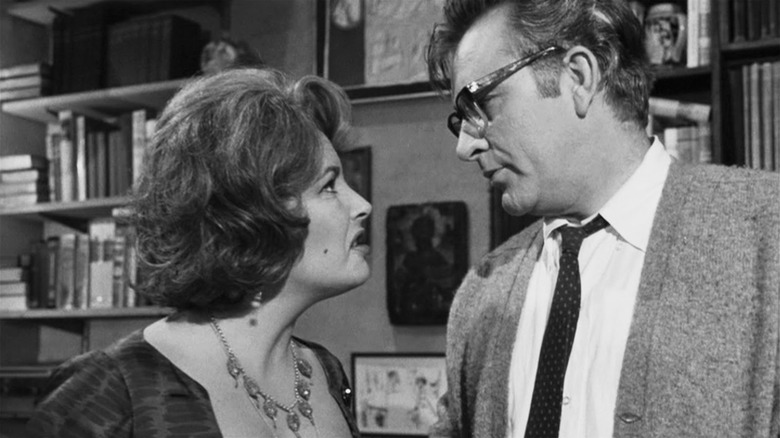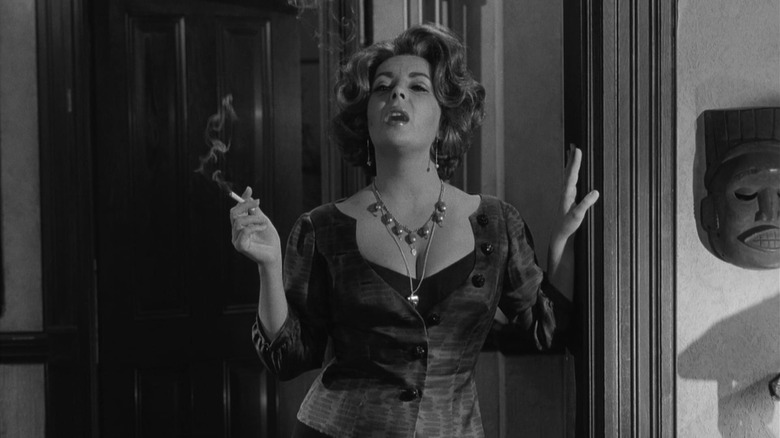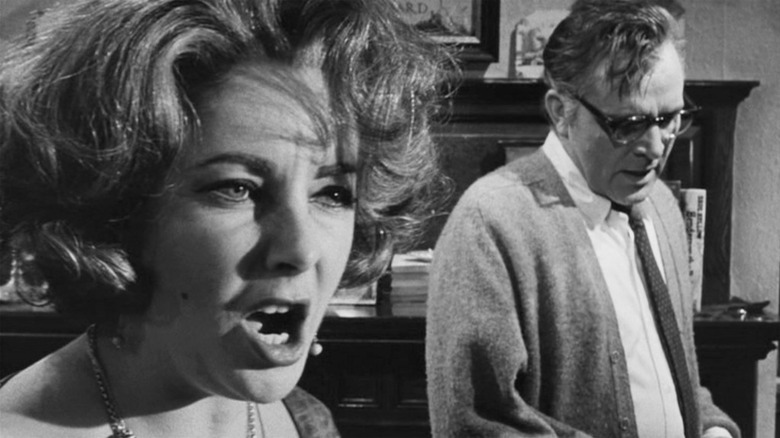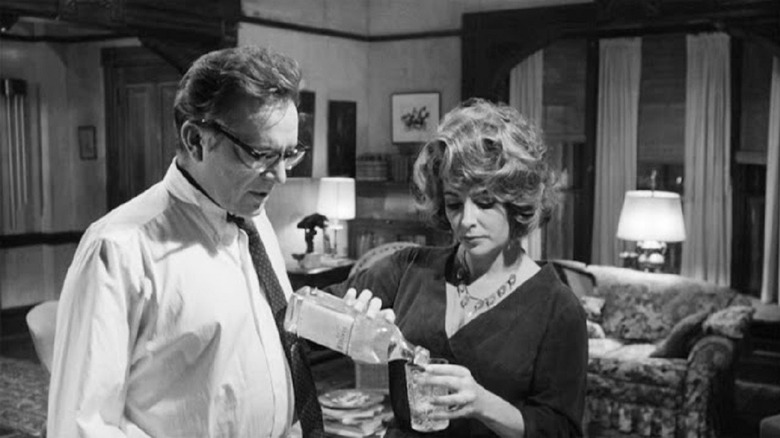Who's Afraid Of Virginia Woolf? Struggled To Keep Its Stars On Set
Edward Albee's 1962 play "Who's Afraid of Virginia Woolf?" is one of the sweatiest, most resentful, least pleasant stories about marriage ever seen on a stage (well, this side of "Oedipus the King," anyway). In 1966, director Mike Nichols and screenwriter Ernest Lehman adapted the play into one of the sweatiest, most resentful, least pleasant stories about marriage ever seen on a screen. "Woolf" is a hothouse of wrath and anger designed to make an audience shift uncomfortably in their seats, mentally taking notes as to what they definitely don't want to talk about after the movie is over. Naturally, the film was nominated for a boffo 13 Academy Awards, winning five.
Elizabeth Taylor was a force of nature in "Woolf," and her depiction of the catty, sardonic Martha perfectly balanced anger of Richard Burton as George. Throughout the film, George and Martha badger and flirt with a younger, more idealistic couple (George Segal and Sandy Dennis) informing them of their inevitable marital downfall, and asking questions like, "did you know our son is about to turn 16 and are we going to start drunkenly sleeping with each other or what? Oh shoot. We weren't supposed to talk about our son."
"Woolf" is soaked in liquor, and all the characters begin confessing multiple relationship transgressions — mostly child-related — while under the influence. As it turns out, Taylor and Burton were perhaps getting a little too deeply into character. On her website, film writer and champion of editors Bobbie O'Steen, whose husband Sam edited "Woolf," asked him about the unique challenges of making the film. Sam was candid about the difficulties of editing the film's overlapping dialogue, but also tempestuous actors who would arrive on set drunk. Perhaps not quite as drunk as their characters, but drunk nonetheless.
Overlapping dialogue
When it comes to scenes with overlapping dialogue, the filmmaking solution may seem simple: Get two separate cameras and train each one on one of the actors. Film two shots simultaneously with one audio track on both, and then — in editing — cut back and forth between the two actors, assembling the scene as the editor's rhythms dictate. This makes for organic scenes reminiscent of live theater. It's also, incidentally, similar to the way most multi-camera TV sitcoms are shot. Unfortunately for Sam O'Steen, this approach wasn't possible because of the caprices of the actors who refused to have multiple cameras on set.
"Mike [Nichols] called me down to the set and said, 'Two people are talking all the time and I want them to overlap, how do I do it?' I said, 'Use two cameras, you know, camera on him, camera on her, you got one track' But one of them wouldn't do it, I think it was Burton, cause he said, 'I can't act when you do that, why don't you shoot one, then the other?' I said, 'Then I'd have to cut the track first.' Mike said, 'Do whatever you have to do.'"
So what did Sam do? His solution required a little more prep time, and was very technical, but ended up making the scenes work beautifully.
"When George and Martha were talking at the same time, I mixed their two tracks together. I did a dub on it, and it came out right, bang, the scene timed out about right, so then I coded the soundtrack [via number codes on the film strips]. I did it twice to match both actors ... I could cut anyplace I wanted to."
A new invention was required to accommodate a difficult actor.
The booze
A bigger problem than an actor who refused to refused to work with multiple cameras was the constant drinking of Taylor and Burton. Both their characters were drunk throughout the course of "Who's Afraid of Virginia Woolf?" and it seems the actors were willing to lend their performances a little too much authenticity. As Sam O'Steen tells it, the two leads would return from their lunch break after having had a few. Sam recalls the interactions between the actors and Nichols:
"[Taylor and Burton] say, 'We'll be down.' Meanwhile, Mike was going crazy. He'd walk around saying, 'C********s, I hate their f***in' guts,' and cry to me that they were costing him time. When they finally came back late, they'd just ignore it all, be real nice. 'Hey, Mike, old buddy, sorry we're late, okay let's shoot.'"
Taylor and Burton would not, according to Sam O'Steen, come back to the set completely bombed, but were definitely a bit tipsy. Their drunkenness wasn't so much an issue as was their tardiness. A stipulation in the actors' contracts ensured a definite time for the end of their working day, and long, booze-infused breaks cut severely into shooting time "[T]hey wouldn't come back 'til five o'clock and they had in their contract that they couldn't work past six o'clock," O'Steen recalls. The longer a shoot, the bigger the budget. With two capricious actors taking long booze breaks, the director started getting in trouble:
"Mike ended up being thirty days over schedule and doubling the budget. The studio thought about kicking Mike off the movie. They tried, but they knew if they fired Mike, the Burtons would both walk."
Less cussing, please
Nichols had an issue with "Who's Afraid of Virginia Woolf?" in addition to his difficult actors, namely: Conflicts with studio head Jack Warner over the amount of cussing in the script. Albee's original play is loaded with F-bombs and other frequently censored examples of off-color language. Notably, O'Steen recalls, Nichols softened one particular cuss word, with Warner only to come along and soften it even further:
"Warner wouldn't fight with anyone directly. But in one scene where George rang the doorbell, Martha said, 'F*** you' in the play, Mike changed it to 'Screw you,' and Warner said we had to put 'God damn you' in her mouth, which is a long way from 'F*** you' and 'Screw you.' And Mike tried to fight that. Also, Mike had been going to New York on the weekends doing commercials with Elaine May, then flying back Monday morning, so Warner said, 'Is he doing that or doing this?'"
Even with the "softened" language, however, "Virginia Woolf" is still a powerful, uncomfortable film, replete with all the dank resentments from Albee's play (left mercifully in tact). Despite the difficult actors and extended shooting schedule, "Woolf" emerged as one of the best films of 1966, and is arguably one of the best films of its decade. The film's 13 Oscar nominations were a benchmark previously reached only by "From Here to Eternity," "Mary Poppins," and "Gone with the Wind" before it.
Nichols and O'Steen endured a lot from Burton and Taylor, but they luckily made a classic.



